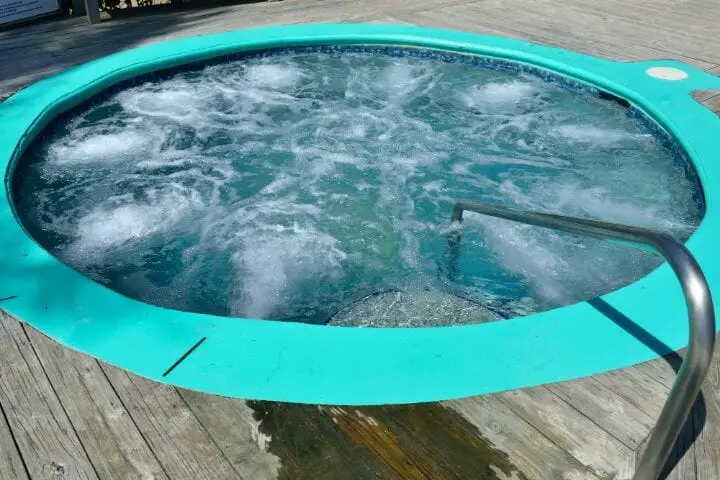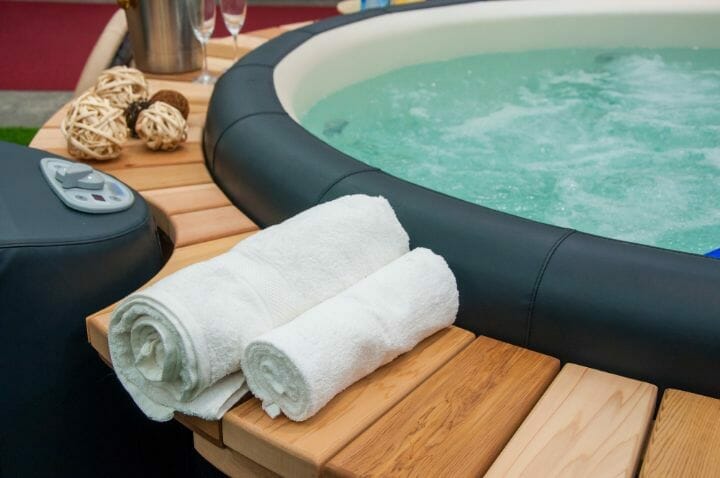Hot tubs have been enjoyed by people for years. They have many therapeutic and relaxing effects as they relax the central nervous system and the rest of the body. They also help you to sweat out toxins that can target the brain which can improve your mood, thinking, and behavior.
Some neurotoxins can increase your risk of cancer, so by sweating out these toxins you may be able to decrease your risk of cancer. Blood flow is also improved so oxygen and other nutrients can be delivered to the body faster.
Hot tubs may also help to alleviate pain, reduce muscle spasms, and relieve congestion.
While there are many benefits to hot tub use, there are also some risks associated. Some people also may be more at risk of adverse reactions than others.
Contents
Can Hot Tubs Make You Sick?
While hot tubs have many benefits, there may be some risks associated with their use. Often the immune system weakens as we age as well, so this may leave elderly people at more risk of getting sick than others.
Many of the risks associated with hot tubs have to do with the build-up of bacteria, so as long as the hot tub is well maintained there is a very low chance of becoming sick.
The hot tub equipment heats circulate and uses water cleansing chemicals to disinfect the water. Hot tubs should also remain covered when not in use.
One type of bacteria commonly associated with hot tubs is Pseudomonas aeruginosa, which causes something called hot tub folliculitis or hot hand-foot syndrome. This often appears several hours to several days after hot tub use and presents as a rash characterized by macules and papules.
Macules are small, flat, red-colored areas and papules are similar however they are raised bumps as opposed to flat areas. This rash is often itchy as well. Other more severe symptoms include fever, possible respiratory issues, and swollen lymph nodes in the armpit (axilla) area.
Another risk associated is the parasite, cryptosporidium. This can spread in hot tubs through fecal matter getting into the water, however, the water must be ingested for someone to pick up this parasite.
So, as long as you do not swallow the hot tub water, there is no reason to worry. This may cause vomiting, diarrhea, nausea or fever.
This parasite is also resistant to chlorine and bromine, which are often the chemicals used to keep the water clean. Urinary tract infections may also be picked up through hot tub bacteria in very rare cases.
You may also like Adaptive Bathroom Equipment
Hot Tubs and Respiratory Disease
There are two respiratory diseases that are caused by bacteria commonly found in improperly cleaned hot tubs. These are Legionnaires’ disease and hot tub lung.
Legionnaires’ disease is a lung infection caused by Legionella bacteria. These bacteria grow best in warm water, so they tend to thrive in hot tubs. However, these bacteria may also be found on showerheads and humidifiers as well.
This disease is a form of pneumonia that can either present as mild or severe. If caught, it can cause headaches, nausea, shortness of breath, chest pain, and coughing.
More severe forms can lead to a larger difficulty breathing as well as respiratory failure. The individuals most at risk with this disease include adults over 50, smokers, individuals with weakened immune systems, and those with lung disease or other conditions (including diabetes, cancer, or kidney disease).
Therefore, elderly people are more at risk. If you happen to catch Legionnaire’s disease and fit into the at-risk criteria, immediate medical attention is the best option.
The other respiratory disease commonly associated with hot tubs is called hot tub lung. This is caused by Mycobacterium avium complex (MAC) which thrives in hot and damp atmospheres and adheres well to surfaces, like the walls or seats in hot tubs.
This causes flu-like symptoms including coughing, fever, trouble breathing, and extreme fatigue. While there is a chance of catching this in hot tubs, it is very rare.
Hot Tubs and Heart Disease
Those with existing heart conditions should be cautious with hot tub use. This is because the hot water causes an increase in body temperature while causes dilation of the blood vessels.
This also causes an increase in perspiration that cannot be evaporated due to the surrounding water which causes vasodilation as well. This vasodilation causes an increased heart rate which may be dangerous to those with heart conditions.
As well, vasodilation combined with the decrease in blood volume because of the loss of fluids (through sweating) can cause a decrease in blood flow to the brain which can cause you to faint or pass out.
The sudden fall in blood pressure, changes in heart’s rate, or changes in the quantity of blood in different areas of the body can also increase the likelihood of fainting.
The changes in the amount of blood in different areas of the body are due to the fact that the blood tends to flow away from the core to the skin in an attempt to cool the body down.
The dehydration resulting from hot tub use can also cause an increase in hematocrit, which causes an increase in oxygen consumption throughout the body.
This can be dangerous to those with angina as it can bring on angina attacks due to the heart not receiving enough oxygen-rich blood. All of these effects combined together also increase the possibility of cardiac arrest in those with existing heart disease.
Certain medications used to treat heart disease may increase risks for adverse effects in hot tubs. These include beta-blockers, which lower the heart rate and limits the blood flow to the skin, and diuretics which increase the excretion of water and salt from the body.
Diuretics combined with dehydration resultant of hot tub use can cause you to become even more dehydrated.
You may also like Best Sliding Transfer Benches With Swivel Seat
Hot Tubs and High Blood Pressure
Individuals with high blood pressure should also proceed with caution when using a hot tub as the effects of being in a hot tub on the body may cause adverse reactions.
This is because extreme changes in body temperature have an effect on blood pressure. Those with high blood pressure also may struggle to maintain a safe blood pressure level when the blood vessels are dilated.
The increase in perspiration causing dehydration causes an increase in blood viscosity. This causes more resistance in blood flow which therefore causes the heart to work harder which can be dangerous to those with high blood pressure. This can also impair the blood flow to the organs.
Elderly people are also at a higher risk of organ perfusion due to a higher likelihood of thickening and hardening in the arteries leading to the heart and brain. Less blood flow to the brain can cause dizziness or headaches.
Additionally, there may be risks for those with low blood pressure as well as hot tub use may cause the blood pressure to drop to a dangerously low level. Hot tub use lowers blood pressure by about the same amount as those with normal blood pressure, however, hypotensive patients will feel the effects more.
For safest use for those with high blood pressure, ensure to get in and out of the hot tub gradually to allow the body to slowly adjust to the temperature changes. 10 minutes is also the safest duration as studies have found that after around 20 minutes, heart rate increases more which can be dangerous.
You may also like Best Safe Bathtubs For Elderly
Other Risks
There are a few other conditions where you should be cautious when using a hot tub. It is recommended that diabetics do not use hot tubs as dilated blood vessels may cause them to absorb insulin much faster than normal.
Rarely epileptic seizures can be caused by any environmental stimuli, like a sudden change in temperature, so those with epilepsy should be cautious. Some people may develop skin rashes or have allergic reactions to come of the chemicals used to keep hot tubs clean.
These chemicals include chlorine, bromine, and potassium peroxymonosulfate, which are used to remove organic contaminants from the water. However, this can usually be prevented by moisturizing after hot tub use.
Some medications may also make hot tub use riskier. Be cautious when on anticoagulants, antihistamines, tranquilizers, or any medications that interfere with the body’s temperature regulation mechanisms.
There is also a drowning risk if you are on any medications that cause drowsiness. The same thing goes for alcohol consumption.
You may also like Best Bariatric Shower Chair
Safety Tips for Seniors
Just because there are risks associated with hot tub use for seniors doesn’t mean you shouldn’t use them. Here are some tips for the safest hot tub experience.
- Do not sit in the hot tub for more than 20 minutes. 10-15 minutes is ideal.
- Use a handrail to get in and out to reduce risk of falling.
- Drink lots of water to combat dehydration.
- Keep the water temperature regulated. 100°F is the safest.
- Check with your doctor to see if any of your medications may cause an adverse reaction.
- It may be a good idea to have someone outside the hot tub supervising to ensure no one falls asleep.
- Do not use a hot tub in the presence of alcohol or other noncontrolled substances.
The video below showcases the health benefits of hot tub use.
Citations.
Are Hot Tubs Safe If You Have Heart Disease? (2020, January 24). In Cleveland Clinic: Health Essentials. Retrieved from https://health.clevelandclinic.org/hot-tubs-can-land-your-heart-in-hot-water/
Ebner, K. (2005). Health and Healing through Water.
Kulkarni, H. S., & Marianna Sockrider, M. D. (2016). What is Legionnaires’ Disease?. American Journal of Respiratory and Critical Care Medicine, 193(4), P5.
Legionnaire’s Disease (2019, September 17). In Mayo Clinic. Retrieved from https://www.mayoclinic.org/diseases-conditions/legionnaires-disease/symptoms-causes/syc-20351747
Press, E. (1991). The health hazards of saunas and spas and how to minimize them. American journal of public health, 81(8), 1034-1037
Shin, T. W., Wilson, M., & Wilson, T. W. (2003). Are hot tubs safe for people with treated hypertension?. Cmaj, 169(12), 1265-1268.
Yu, Y., Cheng, A. S., Wang, L., Dunne, W. M., & Bayliss, S. J. (2007). Hot tub folliculitis or hot hand–foot syndrome produced by Pseudomonas aeruginosa. Journal of the American Academy of Dermatology, 57(4), 596-600.
Zacherle, B. J., & Silver, D. S. (1982). Hot tub folliculitis: a clinical syndrome. Western Journal of Medicine, 137(3), 191.




